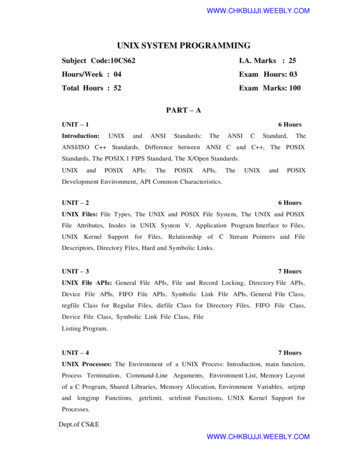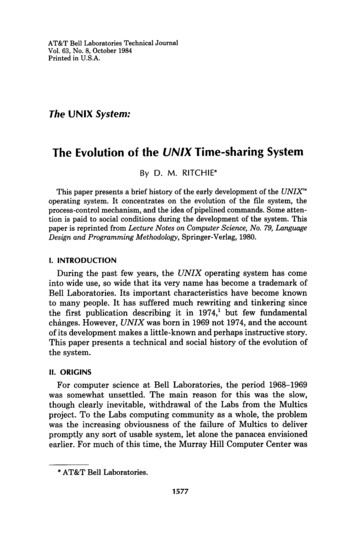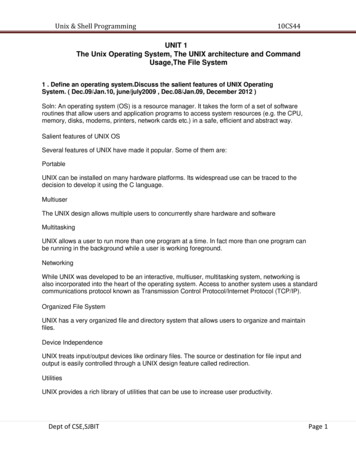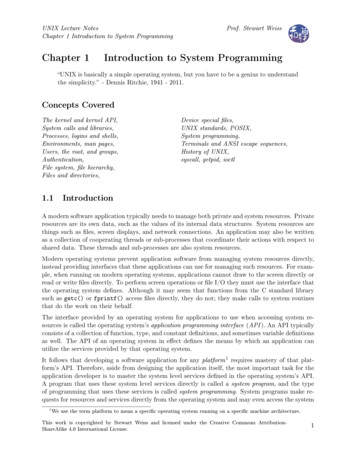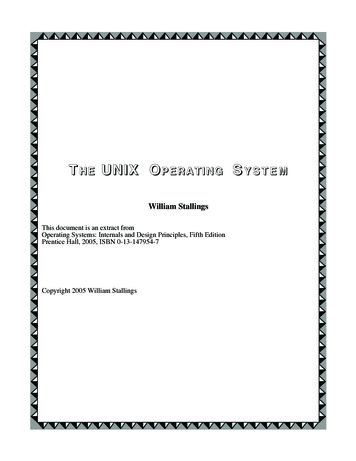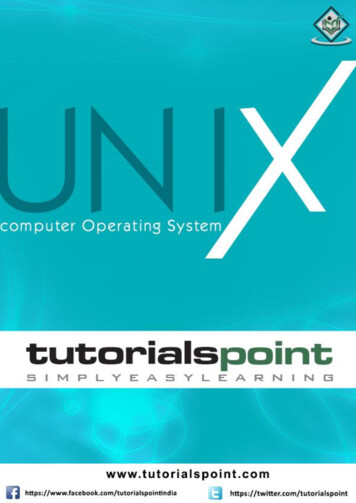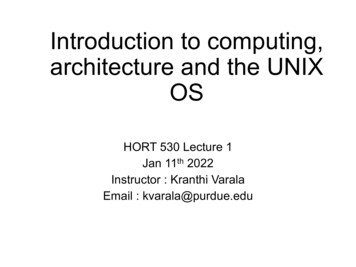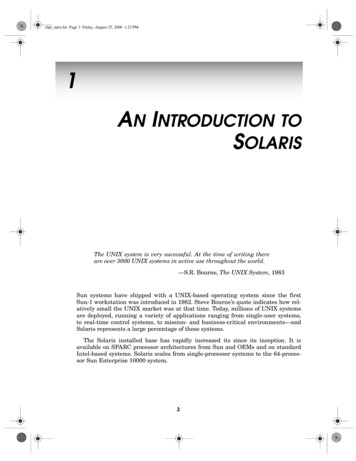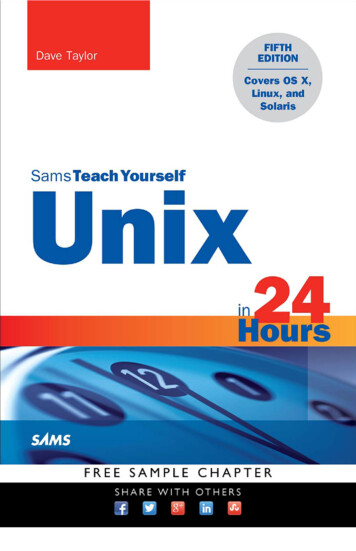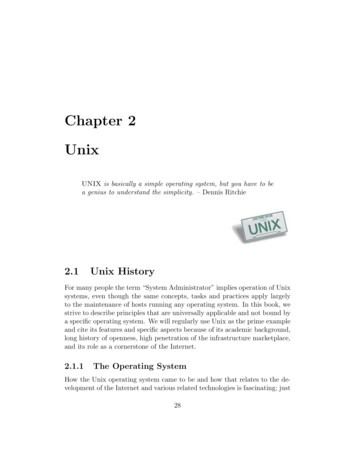
Transcription
Chapter 2UnixUNIX is basically a simple operating system, but you have to bea genius to understand the simplicity. – Dennis Ritchie2.1Unix HistoryFor many people the term “System Administrator” implies operation of Unixsystems, even though the same concepts, tasks and practices apply largelyto the maintenance of hosts running any operating system. In this book, westrive to describe principles that are universally applicable and not bound bya specific operating system. We will regularly use Unix as the prime exampleand cite its features and specific aspects because of its academic background,long history of openness, high penetration of the infrastructure marketplace,and its role as a cornerstone of the Internet.2.1.1The Operating SystemHow the Unix operating system came to be and how that relates to the development of the Internet and various related technologies is fascinating; just28
CHAPTER 2. UNIX29about every other Unix-related book already covers this topic in great detail.In this chapter, we summarize these developments with a focus on the majormilestones along the road from the birth of Unix as a test platform for KenThompson’s “Space Travel” game running on a PDP-7 to the most widelyused server operating system that nowadays also happens to power consumerdesktops and laptops (in the form of Linux and Apple’s OS X), mobile devices (Apple’s iOS is OS X based and thus Unix derived; Google’s Androidis a Linux flavor), TVs, commodity home routers, industry scale networkingequipment, embedded devices on the Internet of Things (IoT), and virtuallyall supercomputers1 . We will pay attention to those aspects that directly relate to or influenced technologies covered in subsequent chapters. For muchmore thorough and authoritative discussions of the complete history of theUnix operating system, please see [2], [3] and [5] (to name but a few).2Let us briefly go back to the days before the Unix epoch. Unix keeps timeas the number of seconds that have elapsed3 since midnight UTC of January1, 1970, also known as “POSIX time”4 . The date was chosen retroactively,since “Unics” – the Uniplexed Information and Computing Service, as the operating system was initially called5 – was created by Ken Thompson, DennisRitchie, Brian Kernighan, Douglas McIlroy and Joe Ossana in 1969. Thatis, Unix predates the Unix epoch!It is interesting and a testament to the clean design to see that the basic1TOP500[1], a project ranking the 500 most powerful computers in the world, listedover 89% as running a version of Linux or Unix.2The “Unix Heritage Society” mailing list[6] is another particularly noteworthy resource in this context. It continues to be an incredible source of historical, arcane, andyet frequently and perhaps surprisingly relevant information and discussions around thehistory of the Unix family of operating systems. It is notable for the regular participationof many of the original developers and researchers from the early days of Unix.3It is worth adding that this does not include leap seconds, thus making Unix time aflawed representation of what humans like to refer to as linear time. Leap seconds areinserted rather unpredictably from time to time, and Unix time has to be adjusted whenthat happens. Worse, negative leap seconds are possible, though have never been required.Just more evidence that Douglas Adams was right: “Time is an illusion, lunch time doublyso.”[7]4This is also the reason why, for example, Spam with a “Sent” date set to 00:00:00may, depending on your timezone o set from UTC, show up in your inbox with a date ofDecember 31, 1969.5The name was a pun on the “Multics” system, an alternative for which it was initiallydeveloped as.
CHAPTER 2. UNIX30functionality and interfaces of an operating system developed over 40 yearsago have not changed all that much. The C programming language wasdeveloped in parallel by Dennis Ritchie[8], for and on Unix. Eventually,Unix itself was rewritten in C, and the programming language became suchan integral part of the operating system, such a fundamental building block,that to this day no System Administrator worth their salt can avoid learningit, even though nowadays most tools running on top of Unix are written inhigher-level, often interpreted languages.The structure of the Unix file system, which we will revisit in much detailin Chapter 4, the basic commands available in the shell, the common systemcalls, I/O redirection, and many other features remain largely unchangedfrom the original design. The concept of the pipe, which defines and represents so much of the general Unix philosophy, was first implemented in1973[10], and we still haven’t figured out a better, simpler, or more scalableway for two unrelated processes to communicate with each other.Since its parent company AT&T was prohibited from selling the operating system6 , Bell Laboratories licensed it together with the complete sourcecode to academic institutions and commercial entities. This, one might argue, ultimately led directly to the very notion of “Open Source” when theComputer Systems Research Group (CSRG) of the University of California,Berkeley, extended the operating system with their patchsets, which theycalled the “Berkeley Software Distribution” or BSD.Likewise, the licensing of this “add-on” software allowed Berkeley Software Design Inc. (BSDI) to develop and sell their operating system BSD/OS.This lead directly to the famous lawsuit[11] by Unix System Laboratories(USL), a wholly owned subsidiary of AT&T / Bell Labs, who did not appreciate BSDI selling their operating system via the 1-800-ITS-UNIX number.It has been argued that this lawsuit eroded some companies’ confidence in theBSD family of operating systems and caused them to adopt a new Unix clonecalled “Linux” despite its more onerous license. Regardless of the “what if”sinvolved, this part of the history is rich in lessons ranging from business logicand legal impact of software licensing to the psychological impact of versionnumbering and other aspects of software product release.76Under a ruling stemming from an anti-trust settlement in 1958[5], AT&T was onlyable to commercially sell Unix after divesting itself from Bell Labs.7For the rather interesting details, including the full ruling of the courts as well as manydiscussions around its repercussions, please see the references at the end of this chapter –the legal battle and its impact on the history of computing alone could fill a book.
CHAPTER 2. UNIX31The di erent direction taken by the CSRG and the commercial entitieswhich licensed and then sold the Unix operating system and the evolution ofthe code as it was merged between these branches ultimately lead to two maindirections: the BSD derived family of systems and the ones tracing back to(AT&T’s) Unix UNIX V, or SysV. The latter had four major releases, withSystem V Release 4, or SVR4, being the most successful and the basis ofmany other Unix versions. Multiple vendors entered the operating systemmarketplace and tried to distinguish themselves from their competitors viacustom (and proprietary) features, which lead to significant incompatibilitiesbetween the systems (and much frustration amongst System Administratorsin charge of heterogeneous environments).It only contributes to the overall confusion that “Version 7 Unix”, thelast version of the original “Research Unix” made available by Bell Labs’Computing Science Research Center, was released prior to and became thebasis of “System III”, from whence “System V” would ultimately derive.8(Linux, not being a genetic Unix – that is, it does not inherit nor share anycode directly with the original version from Bell Labs – can be seen as athird main flavor, as it borrows semantics and features from either or bothheritages. This can at times be both a source of great choice and flexibilityas well as of frustration and confusion.)Software Versioning is Largely ArbitraryAs a wonderful illustration of the absurdity of software versionnumbers, consider Solaris. Internally termed “SunOS 5”, it wasreleased as “Solaris 2” and attempted to correlate SunOS kernelversions to Solaris releases: Solaris 2.4, for example, incorporatedSunOS 5.4. As other competing operating systems had higherversion numbers, it appears that Sun decided to leapfrog to the“front” by dropping the major version number altogether. The releasefollowing Solaris 2.6 became Solaris 7 (incorporating SunOS 5.7).Similarly, 4.1BSD would have been called 5BSD, but AT&T feared thatwould lead to confusion with its own “UNIX System V”. As a result, theBSD line started using point releases, ending with 4.4BSD.8You can download or browse the source code and manual pages of many historicalUnix versions on the website of the Unix Heritage Society[29].
CHAPTER 2. UNIX32I have observed similar “back matching” of OS release versions in morethan one large internet company: officially supported (major) OS version numbers grow point releases that do not exist upstream, reflectinga merging of internal versions such that third-party software does notbreak.Fragile as this approach is, it reflects a SysAdmin’s ability to meet conflicting needs (track OS versions without incrementing the release numbers) in a practical manner.Throughout the eighties, a number of di erent versions of Unix came intoexistence, most notably Hewlett-Packard’s HP-UX (SysV derived; originallyreleased in 1984), IBM’s AIX (SysV derived, but with BSD extensions; originally released in 1986), Microsoft’s Xenix (derived from “Version 7 Unix”;originally released in 1980; ownership of Xenix was later on transferred toSanta Cruz Operation (SCO), where it was ultimately succeeded by “SCOUNIX”), SGI’s IRIX (SysV derived, but with BSD extensions; originallyreleased in 1988) and Sun Microsystems’s SunOS (BSD derived; originallyreleased in 1982 and later on superseded by their own SysV derived Solaris).Even though these systems were commercial, innovations from one easilyflowed to the others. For example, a number of important and now ubiquitousfeatures such as the Virtual File System (VFS) and the Network File System(NFS) were developed at Sun, which was co-founded by Bill Joy, who hadbeen a graduate student in the CSRG at Berkeley, where he worked on variousBSD releases and created a number of important tools, including the vi(1)editor and the csh(1) command-line interpreter.Not surprisingly, the code released under the permissive BSD-License[13]was equally quickly adapted and integrated into the commercial versions.This included the Berkeley Fast File System (FFS) (also known as the UnixFile System (UFS)), the BSD Sockets library and Application Programming Interface (API), and of course the DARPA sponsored integration ofthe TCP/IP suite (initially developed by BBN Technologies, one of the companies contracted to implement the protocols). The BSD-derived TCP/IPcode finally found its way into virtually every major operating system, including Microsoft Windows.Linux, one of the most widely used Unix versions today – technically
CHAPTER 2. UNIX33a “Unix-like” operating system, as it inherits from neither the SysV northe BSD lineages – has its own unique history, invariably tied to that ofthe GNU Project. Developed on and inspired by MINIX, it was created in1991 by Linus Torvalds as a “(free) operating system [.] for 386(486) ATclones”[12]. Since a kernel all by itself does not an operating system make,Linux was soon bundled with the freely available software provided by theGNU Project and, like that software, licensed under the GNU General PublicLicense.The GNU Project in turn was started by Richard Stallman in 1983 9 toprovide a Unix-like operating system, and by 1991 it provided a large number of essential programs and tools (starting with the ubiquitous emacs(1)editor) and of course including the GNU Compiler Chain gcc(1), the GNUC Library (glibc), as well as the GNU Core Utilities; however, it was still inneed of a kernel. When Linux was released, it filled this void and GNU/Linuxwas born. It is interesting to note that despite the unique license this operating system was released under – in a nutshell: you get the source and arefree to use and modify it, but any modifications need to be released underthis same license – it has found widespread adoption by commercial entitiesand countless products are based on it.Di erent organizations, both commercial and volunteer-based, have sprungup to provide di erent versions of the GNU/Linux OS. Inherently similar ona fundamental level, they tend to di er in their package manager (see Chapter 5.5 for a detailed discussion of these components), administrative tools,development process, and user interface choices. Some companies trade rapidadoption of new features available in the open source kernel for a reputationof stability and o er commercial support for their particular Linux flavor.Even though nowadays hundreds of these Linux distributions exist, thetwo dominant variations in the server market tend to be those based on“Red Hat Enterprise Linux” as well as derivatives of Debian GNU/Linux.The former, a commercial product licensed to users by Red Hat, Inc., gavebirth to the “Fedora” and CentOS community projects, while in 2012 Canonical Ltd.’s “Ubuntu” OS became the most widely used Debian derivative.Changes to the core components continue to be merged across all distributions, but the specific bundling of custom tools lead to di erent Linux flavorsdrifting further apart.9Note that this makes the GNU project 8 years older than Linux!
CHAPTER 2. UNIX34Figure 2.1: A partial Unix genealogy tree.With all this back and forth between the various versions, trying to keeptrack of the entire genealogy of the Unix family of operating systems is noeasy task. Figure 2.1 provides an incomplete and simplified visualization ofthe main directions; a much more complete graph of the Unix history can beseen on the “Unix Timeline”[14] – printed on letter-sized paper, the graphis over 25 feet long! Many System Administrators have covered their officewalls with this reminder of the complex history of their favorite operatingsystem.Parallel to the development of the various Unix flavors evolved a set ofstandards that helped define how exactly the operating system should behave, what interfaces it should provide and what kinds of assumptions thirdparty software could make about the environment. These standards becameto be known as the “Single UNIX Specification” (SUS, commonly referred byversion, such as SUSv3) and eventually as “POSIX” (for “Portable OperatingSystem Interface for uniX”). The SUS was used to qualify operating systemsfor the name “UNIX” – this certification was obtained only by a relativelysmall number of systems, since it was costly and required re-certification of
CHAPTER 2. UNIX35the system after any significant change (i.e., major OS release), somethingthat Open Source projects, such as the BSDs certainly could not a ord.Eventually, SUSv3 and POSIX:2001 (formally known as IEEE 1003.12001) became more or less interchangable; we will commonly refer to systems or interfaces as being “POSIX-compliant” (or not, as the case may be).At the time of this writing, the latest version is POSIX:2008[15], which isdivided into a Base Definition, the System Interfaces and Headers, and theCommands and Utilities. It should be mentioned, though, that not only is“the nice thing about standards that you have so many to choose from”[16],as an old phrase coined by Andrew S. Tanenbaum goes, but also that a recommendation or requirement does not necessarily have to make sense or berealistic to be included in a standard. We will occasionally notice discrepancies between what POSIX demands and what di erent OS vendors chose toimplement. As two entertaining examples, please refer to the section of thefcntl(2) manual page on e.g. a NetBSD system[17] that elaborates on thelocking semantics or the fact that POSIX could be interpreted to require acd(1) executable10 .2.1.2NetworkingNo review of the history and basic features of the Unix operating systemwould be complete without a mention of the parallel evolution of the Internet. As we noted in Section 2.1.1, the development of the Unix systemand that of the predecessors of what ultimately became the Internet werenot only related, but became inseparably merged. The ARPANET implemented the concept of packet switching, allowing payload to be broken intosmall datagrams and routed along di erent paths; its adoption of TCP/IP[20]as its protocol suite e ectively marked the beginning of the modern Internet. Even though some companies developed their own TCP/IP stack, thecode included in the Berkeley Software Distribution quickly became the mostwidely used implemention and ultimately replaced other network protocols11 .In the early days of the Internet, the various di erent networks – ARPANET,10If the problem of a cd(1) executable isn’t immediately obvious to you. well, seeProblem 4!11Microsoft, for example, did not include TCP/IP in their operating systems until Windows 95, allowing other companies to sell their implementations as add-on software. Themove from their native NetBIOS protocol to the BSD derived TCP/IP stack helped makethe latter the de-facto Internet standard protocol suite.
CHAPTER 2. UNIX36CSNET, MILNET, NSFNET, NSI, etc. – were connected via specific gatewayhosts, and email exchanges as well as communications on the early BBSesand Usenet were performed via UUCP, the Unix-to-Unix Copy tools12 . Oncehosts were more frequently directly connected to the Internet, SMTP andNNTP became more widely used, leading to Unix servers running various socalled dæmons to provide network services as part of their normal operations.But even before the advent of the Internet, Unix included networkingcapabilities. Through its layers of abstraction it was possible to implementsupport for di erent networking technologies and allow applications to benetwork protocol agnostic. In fact, some applications, such as email wereavailable and in use prior to any traditional networking capabilities. The nature of Unix as a multiuser system lead to the development of tools, amongstthem the mail(1) program, to allow these users to communicate efficientlywith one another and across systems. We will frequently review how thenature of a scalable tool allows it to function equally well regardless of whereinput data comes from or what transport mechanism is used; a simple, welldefined program can deliver mail on a single system while relying on a separate transport service (i.e., UUCP or SMTP) to handle connections withother systems.Furthermore, the software implementing such services was developed onand then included in the Unix operating system. As a result, the Internetand its infrastructure were growing in parallel to the capabilities of Unix, oneenabling the other to become more powerful and ubiquitous. And so today,the overwhelming majority of the systems powering the core infrastructurecomponents of the Internet, such as, for example, the DNS root servers ormost web- and mail servers, are running on a Unix variant13 : the by far mostpopular implementation of the DNS specification is, not surprisingly, theBerkeley Internet Name Domain (BIND) server[21]; sendmail, exim, andpostfix push the majority of the world’s email[22]; the apache web serverstill handles more than 45% of all HTTP traffic on active sites than any otherweb server[23].12Every now and then you may encounter a scru y oldtimer who insists on pointing outthat their email address is something along the lines of “.!orgserver!deptserv!mybox!user”.You can trivially impress them by calling it their “bang path” and agreeing that @-basedemail addresses are newfangled humbug.13As noted in the introduction, we continue to count Linux as a “Unix variant” to avoidconstant repition of the phrase “Unix or Linux”.
CHAPTER 2. UNIX2.1.337Open SourceUnix is an inherently open system. Developed at a renowned research institution, it was released and licensed together with the source code long beforethe formal idea of “Open Source” had manifested itself. As we have seenin Section 2.1, the availability of the source code made it possible for othervarious commercial versions to be developed by di erent companies, but italso allowed the development of the Berkeley Software Distribution (BSD)with its distinctly permissive licensing terms.Having access to the source code of the operating system and all thetools in use is a foreign concept in the world of proprietary software, wherethe source code is guarded as a trade secret, the pillar upon which a traditional company builds its entire profit model. Within the academic worldin which Unix was developed, however, access to the source code was onlynatural. Peer review and openness were fundamental parts of this worldand the system was targeted towards engineers, hackers, advanced users whowould naturally like to make changes to tools, who would want to extend thecapabilities and add new features.This wish to share one’s work with others, to allow others to take fulladvantage of it, and to make their own modifications took two distinct directions early on, embodied in the two open source license models that haveremained dominant to this day. On the one hand, the distinctly academicBSD-License (see Listing 2.3) allowed for any use of the software whatsoever(including modification and commercial re-selling of the products) so long ascredit was given where credit was due. On the other hand, the GNU GeneralPublic License (GPL), written by Richard Stallman intended to very specifically not only grant, but to enforce certain freedoms using a moral argument.This license, somewhat ironically, imposes a number of restrictions on whatyou can do with the source code you have received, most notably the requirement to make public under the same license any changes you distribute.People have argued about the benefits of one license over the other fordecades by now, and we will not attempt to resolve the dispute in this book.They represent di erent approaches to one’s software, perhaps a personalchoice of how one wishes that it be used in the future. Suffice it to say thatthere is incredible software licensed using both approaches, and both models thrive to this day. A similar discussion involves the concept of cost andfreedom with regards to software (“Free as in beer versus free as in speech”).Open Source software, like all software, comes at a price: a relatively small
CHAPTER 2. UNIX38component of the total cost of ownership is the actual purchase price, andaccess to the source code (which in some cases may well come under specificterms of the license with commercial and/or closed source software) is somewhat independent thereof. What’s more important – within the context ofthis book, anyway – is that the very concept of Open Source is embeddedin the Unix philosophy and culture, and as a result System Administratorsfrequently expect to be able to analyze the source code to the applicationsand operating systems they run.But not only are we able to inspect how a piece of software works, weneed to. All too frequently do we encounter problems or try to analyze asystem’s behaviour where the question of what on earth might be going onis answered with this advice: “Use the source, Luke!” – Unix has let us doprecisely that since the beginning.142.2Basic Unix Concepts and FeaturesThe Unix operating system consists, somewhat simplified, of three majorcomponents: a kernel, which controls the hardware, schedules tasks, and interfaces with the various devices; a set of libraries, which provide an interfaceto the kernel (in the form of system calls that run in privileged kernel spaceas well as unprivileged library functions running in user space); and a setof tools and applications (often referred to as the “userland”) using theselibraries to provide functionality to the end user.Most Unix flavors use a monolithic kernel, but allow for dynamicallyloaded kernel modules.15 This approach allows for a reduction of the kernelfootprint and increased flexibility, as device driver support can be addedor removed at runtime without requiring a reboot. The kernel, managingthe system’s resources, is running in supervisor mode and exposes facilitiesvia system calls. It is desirable to keep the number of these entry pointsinto kernel space limited and let higher-level library functions provide added14It should be mentioned that the various commercial Unix versions represent closedsource systems. But not only are Open Source Unix versions nowadays much more widelyin use, virtually all of the core software running on top of the (commercial, closed, open,or any other) OS traditionally comes with its source code.15A discussion of microkernels, unikernels, and the various containers that became popular in more recent years is, unfortunately, well beyond the scope of this chapter. Thebroad subject matter of System Administration again forces us to focus on the generalprinciples first.
CHAPTER 2. UNIX cmd outputcmd / dev / nullcmd / dev / null 2 &1cmd inputcmd1 cmd239#####redirection of stdout to a filesuppression of outputsuppression of all outputaccepting input from a filefeeding output from cmd1 into cmd2# Of course these redirections can be combined . cmd1 2 / dev / null cmd2 cmd3 2 &1 cmd4 file 2 outputListing 2.1: Simple I/O redirection in the shellfunctionality executed in unprivileged mode. Therefore, most Unix versionshave only a comparatively small number of system calls: as of January 2017,NetBSD, for example, had only around 482 such calls[18], with only minimalexpected growth16 .Utilizing these system calls and library functions, the higher level toolsand applications are able to interface with the kernel and execute on the user’sbehalf. These binaries then can be divided into a number of categories, suchas executables essential for the basic operation of the system, tools primarilyintended for use by the system administrator, and general purpose utilities.We will revisit this topic in more detail in Chapter 5.2.2.1The shellThe Unix shell, while in many ways nothing but a regular executable, takesa special place in the list of utilities and commands available on the system.The shell provides the primary user interface, allowing for the invocationand execution of the other tools. AT&T’s Version 7 Unix included the socalled “Bourne shell” (named after Steven Bourne) installed as /bin/sh. Inaddition to the ability to invoke other commands, the shell was designed asa command interpreter both for interactive use as well as for non-interactiveuse. That is, it included a scripting language, allowing for complex series ofcommands to be executed; for example, by system startup scripts at boottime.1716Revisiting an earlier draft of this chapter from January 2012 listed 472 system calls.That is, over the course of five years, only ten new system calls were added.17It is worth noting that the early Bourne shell also included support for pipelines(invented by Douglas McIlroy and added to Unix by Ken Thompson in 1973).
CHAPTER 2. UNIX40Various other shells have been created since then, mostly following eitherthe general Bourne shell syntax or that of Bill Joy’s C csh(1) Shell. Themost notable shells today include: the Almquist shell ash(1), a BSD-licensedreplacement for the Bourne shell, frequently installed as /bin/sh on thesesystems; the GNU Project’s Bourne-again shell bash(1), which is the defaultshell on most Linux systems and known for a large number of added features;the Korn shell ksh(1), named after David Korn and which became the basisfor the POSIX shell standard; the TENEX C shell tcsh(1), a C shell variantdeveloped at Carnegie Mellon University; and perhaps the Z shell zsh(1)another very feature rich Bourne shell variant.As a scripting language and due to its availability on virtually every Unixflavor, /bin/sh is assumed to be the lowest common denominator: a Bourneor Bourne-compatible shell. On Linux, bash(1) is typically installed as both/bin/bash and /bin/sh, and it behaves (somewhat) accordingly based onhow it was invoked. Unfortunately, though, its ubiquity on Linux systemshas led to a shell scripts masquerading as /bin/sh compatible scripts thatare, in fact, making use of bash(1) extensions or rely on bash(1) compatibility and syntax. This becomes frustrating to debug when trying to runsuch scripts on a platform with a POSIX compliant /bin/sh.All Unix shells include the ability to perform I/O redirection. Each program has a set of input and output channels that allow it to communicatewith other programs. Like the concept of the pipe, these streams have beenpart of Unix’s design from early on and contribute significantly to the consistent user interface provided by all standard tools: a program accepts inputfrom standard input (or stdin) and generates output on standard output (orstdout); error messages are printed to a separate stream, standard error (orstderr).The shell allows the user to change what these streams are connected to;the most trivial redirections are the collection of output in a file, the suppression of output, acceptance of input from a file, and of course the connectionof one program’s output stream to another program’s input stream via a pipe(see Listing 2.1 for Bourne-shell compatible examples).The concept of these simple data streams being provided by the operating system was inherent in the Unix philosophy: it provided abstraction ofinterfaces, reduced overall complexity of all tools using these interfaces, anddictated a simple text stream as the preferred means of communication. Wewill have more to say on the Unix philosophy in Section 2.2.4.
CHAPTER 2. UNIX41Figure 2.2: Standard streams in a simple pipelineFinally, the unix shell provides for job control, a necessity for a multitaski
Unix UNIX is basically a simple operating system, but you have to be a genius to understand the simplicity. –DennisRitchie 2.1 Unix History For many people the term “System Administrator” implies operation of Unix systems, even though the same concepts, tasks and practices apply largely to the mainte

